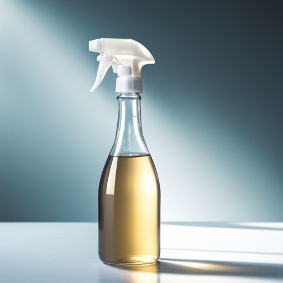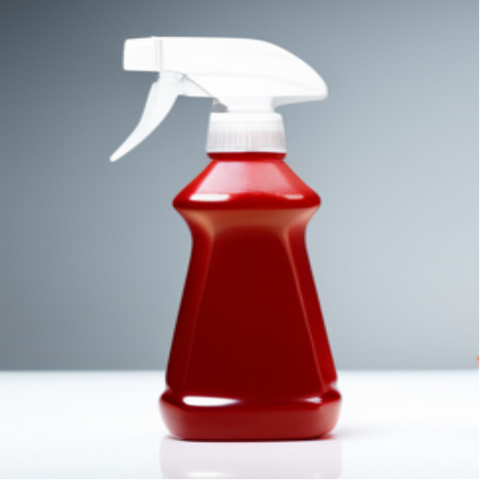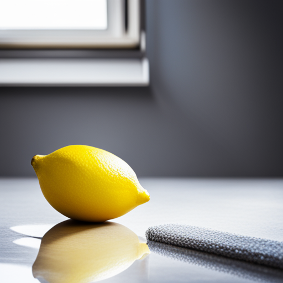Aluminium is a versatile metal that is used in various industries. It is lightweight, strong, and resists corrosion. However, like any other metal, it is susceptible to tarnishing, surface stains and oxidisation. Cleaning aluminium can be a challenge if you are not aware of the proper techniques. In this blog post, we are going to cover the ultimate guide to cleaning aluminium and ensuring it looks and shines like new. You will be amazed at what products can be used to clean Aluminium!
Know Your AluminiumBefore starting a cleaning process, you need to know what type of aluminium you are dealing with. Check if the aluminium is anodised, coated, or raw. Each type requires different cleaning methods. Anodised aluminium has a protective layer that can withstand harsh cleaning agents, while coated aluminium may not. Raw aluminium can be cleaned with mild soap and water, but abrasive agents may leave scratches. Identify the type of aluminium and choose a cleaning agent that is appropriate.
Cleaning Aluminium with White Vinegar
No matter how careful we are, aluminium surfaces are bound to accumulate dirt, grime, and stains over time. Keeping aluminium clean not only improves its appearance but also ensures its longevity. While there are many commercial cleaners available, some of them can be harsh and costly. Thankfully, you can easily clean aluminium surfaces at home with a simple yet powerful ingredient - white vinegar.

White vinegar is an acidic liquid made from distilled alcohol and water. It has been used as a cleaning agent for centuries due to its powerful properties. It is non-toxic, affordable, and readily available in most households. Moreover, it is environmentally friendly and poses no risk to human health when used properly.
How Does It Work?The acidic nature of white vinegar makes it effective against dirt, grime, and stains on aluminium surfaces. When applied, the acid helps break down oxidation and tarnish, leaving a clean and shiny surface. Its low pH also helps neutralize alkaline substances, making it an excellent choice for regular maintenance.
Preparing to Clean Aluminium
Before using white vinegar on your aluminium surfaces, there are a few things to keep in mind:
- Always use distilled white vinegar as it is more acidic than other types.
- Avoid using undiluted vinegar as it can be too harsh and damage the surface.
- Test a small area first to ensure that the vinegar does not cause any damage or discoloration.
Steps for Cleaning Aluminium
Now that you are ready, here's how you can clean aluminium surfaces with white vinegar:
- Dilute the vinegar: Mix equal parts of distilled white vinegar and water in a spray bottle or a bowl.
- Apply the solution: Spray or apply the solution on the aluminium surface, ensuring that all areas are covered.
- Let it sit: Allow the vinegar mixture to sit for about 10-15 minutes to allow it to penetrate and loosen any dirt or stains.
- Scrub gently: Using a soft sponge or cloth, scrub the surface gently in circular motions. For tougher stains, you can use a soft-bristled brush.
- Rinse and dry: Once the surface is clean, rinse it thoroughly with water and wipe it dry with a clean cloth or towel.
- Repeat if necessary: If there are still stubborn stains or dirt, you can repeat the process until the desired results are achieved.
Tips for Maintaining Cleanliness
Regularly cleaning your aluminium surfaces with white vinegar can help maintain their shine and prevent any build-up of dirt or grime. Here are a few tips to keep in mind:
- Wipe down the surface with a mixture of water and vinegar after each use.
- Avoid using harsh chemicals or abrasive cleaners on aluminium as they can cause damage.
- Use a microfiber cloth or sponge to avoid scratching the surface.
- Dry the surface thoroughly after cleaning to prevent water spots or corrosion.
- For outdoor aluminium surfaces, consider applying a protective coating to prevent oxidation and maintain its shine.
Cleaning aluminium with white vinegar is an effective and affordable method that can help keep your surfaces looking shiny and new. Whether it's for household items or outdoor furniture, white vinegar is a natural and safe alternative to harsh chemical cleaners. Remember to follow these steps and tips for maintaining cleanliness to keep your aluminium surfaces looking their best. So next time you notice dirt or stains on your aluminium items, reach for that bottle of white vinegar and give this method a try! You'll be amazed at the results. Remember to always use caution when handling chemicals and to follow proper safety protocols.
Cleaning Aluminium with Cream of Tartar
Cream of tartar, also known as potassium bitartrate, is a by-product of the winemaking process. It is a white powdery substance that is commonly used in cooking and baking, but it also has many other household uses – one of them being cleaning aluminium.
How Cream of Tartar Works on Aluminium
Cream of tartar contains acidic properties that make it an effective cleaner for aluminium. When mixed with water, it forms a mild acid called potassium bitartrate, which helps in removing dirt, grime, and stains from the surface of aluminium.
The acidic nature of cream of tartar makes it perfect for cleaning tarnished and dull aluminium. It can dissolve and break down build-up residue on the metal's surface without causing any damage.
Steps to Clean Aluminium with Cream of Tartar
Cleaning aluminium with cream of tartar is a simple and cost-effective process that can be done at home. Here are the steps you need to follow:
- Mix equal parts of cream of tartar and water to create a paste.
- Apply the paste onto the surface of the aluminium, making sure to cover all areas.
- Let it sit for 10-15 minutes.
- Use a soft-bristled brush or sponge to gently scrub the surface in circular motions.
- Rinse off the paste thoroughly with clean water.
- Dry the aluminium with a clean cloth or towel.
Additional Tips and Precautions
- Cream of tartar is safe to use on most types of aluminium, including pots and pans, utensils, and household appliances. However, it is always best to test a small area first before applying it to the entire surface.
- Do not use cream of tartar on anodized or coated aluminium surfaces as it may cause damage.
- For tougher stains and build-up, you can add a small amount of white vinegar to the cream of tartar paste for added cleaning power.
- Always wear gloves when handling cream of tartar as it can irritate the skin.
- After cleaning, it is recommended to rinse off the aluminium with hot water and dry it immediately to prevent water spots.
Cream of tartar is an effective and natural cleaner for aluminium. It not only removes tarnish and build-up, but it also leaves a shiny and polished finish. With these simple steps and precautions, you can easily clean your aluminium items at home without having to spend money on expensive cleaning products.
Remember, always use caution when handling cream of tartar and test on a small area before applying it to the entire surface. And if you have any concerns or doubts, consult with a professional cleaner for advice.
Cleaning Aluminium with Tomato Ketchup
Many people turn to harsh chemicals or expensive cleaning products to restore the shine of their aluminium items. But did you know that tomato ketchup, a common condiment found in most kitchens, can be used to clean aluminium?

Why Tomato Ketchup?
You may be wondering why tomato ketchup is an effective cleaner for aluminium. The secret lies in its acidic nature. Tomatoes contain citric and ascorbic acid, which can help break down the dirt and grime on the surface of aluminium. Additionally, ketchup also contains vinegar, another acidic ingredient that helps with cleaning.
Step-by-Step Guide
- Prepare your aluminium item by rinsing it with warm water to remove any loose debris or dirt.
- Apply a generous amount of tomato ketchup directly onto the surface of the aluminium.
- Use a soft cloth or sponge to spread the ketchup evenly and gently rub it into the metal.
- Let the ketchup sit on the surface for 10-15 minutes. This will allow the acids in the ketchup to work their magic and break down any stubborn stains or grime.
- After the allotted time, use a clean cloth or sponge to wipe away the ketchup and rinse the item with warm water.
- If there are still some stubborn stains remaining, you can repeat the process or use an old toothbrush to gently scrub them away.
- Once all the ketchup residue has been removed, dry the aluminium item with a clean towel or cloth.
Tips and Tricks
- Avoid using abrasive sponges or steel wool when cleaning aluminium as they can scratch the surface.
- After cleaning, you can also use a small amount of olive oil to polish and protect the aluminium. Just make sure to wipe away any excess oil with a clean cloth.
- This method works well for both shiny and matte aluminium surfaces.
- Regular cleaning with tomato ketchup can also help prevent tarnishing and keep your aluminium items looking like new.
Who knew that something as simple as tomato ketchup could have so many household uses? Not only will you save money on costly cleaning products, but you'll also be reducing your environmental impact by using a natural and non-toxic alternative. Give it a try and see the amazing results for yourself! Also, remember to always conduct a patch test on a small, inconspicuous area before using ketchup as a cleaning solution to ensure it doesn't cause any damage.
Cleaning Aluminium with Lemons
Another effective way to clean aluminium is by using lemons. Lemons are considered as natural cleaners due to their acidic properties. The acid in lemons breaks down dirt and grime, making it easier to remove from the surface of aluminium.

To use lemons for cleaning aluminium, you will need:
- Lemons
- Water
- Soft cloth or sponge
- Cut a lemon in half and squeeze the juice into a small bowl or container.
- Add water to dilute the lemon juice.
- Dip the cloth or sponge into the mixture and use it to gently scrub the aluminium surface.
- Rinse off any residue with clean water and dry the surface with a soft cloth.
The citric acid in lemons helps to dissolve any dirt or grime on the aluminium surface, leaving it clean and shiny. It is also a natural alternative to chemical cleaners, making it an eco-friendly option for cleaning.
Precautions when using Lemons
While lemons are a natural cleaner, there are a few precautions to keep in mind when using them to clean aluminium:
- Avoid using lemons on coloured or anodized aluminium surfaces as the acid may cause discoloration.
- Test the lemon mixture on a small, inconspicuous area of the aluminium surface first before cleaning the entire surface.
- Do not leave the lemon mixture on the aluminium surface for too long as it may cause etching or damage to the surface.
- After cleaning with lemons, make sure to rinse off any residue thoroughly to prevent any potential corrosion.
Other Benefits of Using Lemons
Aside from being an effective cleaner for aluminium surfaces, there are other benefits to using lemons:
- Lemons have a fresh scent that can leave your home smelling clean and citrusy.
- The citric acid in lemons also has antibacterial properties, making it a natural disinfectant for surfaces.
- Lemons are easily accessible and affordable, making it a budget-friendly option for cleaning.
Overall, using lemons to clean aluminium is a safe, natural, and effective method. With proper precautions, you can have a sparkling clean surface without the use of harsh chemicals. So why not give this natural cleaning method a try and enjoy all the benefits of using lemons.
Remember to test any cleaning product on a small, inconspicuous area before using it on the entire surface. This will ensure that the product is safe and effective for your specific aluminium item. It is also essential to rinse the aluminium after cleaning to ensure there are no streaks.
Maintaining Aluminium Surfaces
In addition to regular cleaning, there are a few maintenance tips you can follow to keep your aluminium items in top condition:
- Avoid leaving aluminium items in damp or humid areas for extended periods of time as this can cause corrosion.
- If your aluminium item has a protective coating, make sure to reapply it as recommended by the manufacturer to prevent damage and maintain its shine.
- When storing aluminium items, avoid stacking them on top of each other as this can also result in scratches and damage.
Cleaning aluminium is relatively easy, all you need is a little knowledge and gentle cleaning agents. It is essential to identify the type of aluminium you are dealing with and choose the appropriate cleaner. Always use a soft cloth and avoid abrasive agents that can leave scratches. Regular cleaning, polishing, and waxing will maintain your aluminium's shine and keep it looking new for years. Now that you have learned the ultimate guide to cleaning aluminium, you can maintain your metal's shine and durability.











